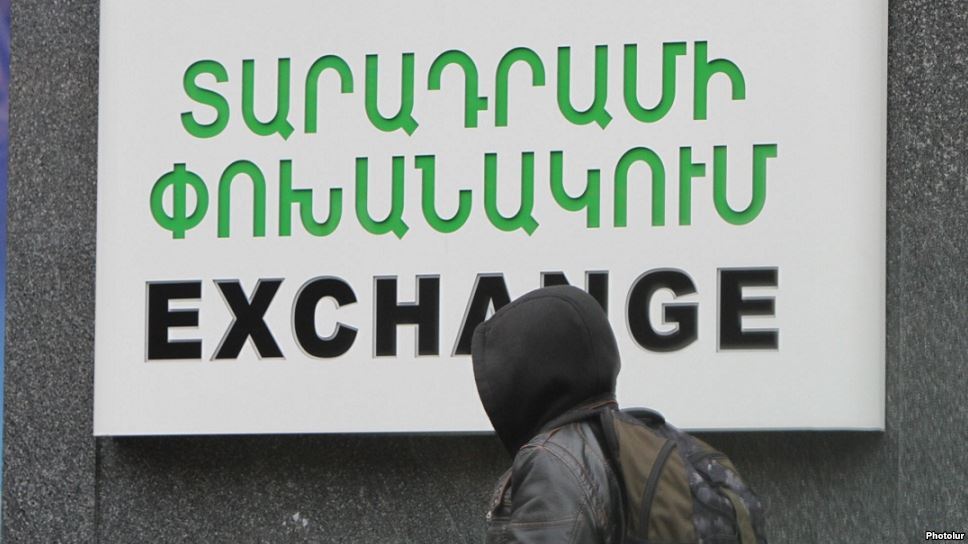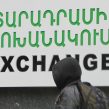
Russia’s Faltering Economy Causing Currency Crisis in Armenia
Publication: Eurasia Daily Monitor Volume: 12 Issue: 1
By:

Armenia’s strong economic dependence on the Russian Federation is dramatically being highlighted at the moment by the devaluation of the Russian ruble and the general economic decline in Russia. The structure of Armenia’s economy and the character of its relationship with Russia suggest that Armenian citizens will experience more economic hardship in 2015.
Before the end of November 2014, the exchange rate of the Armenian dram remained relatively stable, even though gradual depreciation of the Russian ruble had already been occurring for several months. However, as the depreciation of the ruble accelerated, Armenia’s currency markets began to react along the same trajectory. The exchange rate of the Russian ruble changed from 44.40 rubles per US dollar on November 6, to 47.66 on November 28; and then a sharper decline began, until the Russian currency hit a historic low, on December 18, of 67.80 rubles per dollar (Val.ru, accessed January 1, 2015). In comparison, the US dollar exchange rate in Armenia went from 414 dram on November 6 to 433.70 dram on November 28; and the peak was observed on December 17, when the Central Bank’s official rate was 527.20 (Cba.am, accessed January 1, 2015), although commercial banks set buying rates as high as 550 dram and sold the Armenian currency for 570–575 (Rates.am, accessed January 1, 2015), or even stopped selling hard currency altogether. The ruble and dram rallied briefly after that. By December 23, a rate of 56.50 rubles per dollar was reached in Russia, and 458.50 dram per dollar in Armenia. Since then, their gradual devaluation resumed.
Representatives of the Armenian government and the Central Bank claimed that the dram’s sharp depreciation was provoked by certain commercial banks’ “profiteering,” and even launched a criminal investigation against personnel of some currency exchange offices. However, a former chair of the Central Bank, Bagrat Asatryan (in office until 1998), pointed out in an interview with Kentron TV that between January and October 2014, the Central Bank had sold $714 million from foreign currency reserve in order to prevent the dram’s depreciation (YouTube, December 23, 2014). Currency interventions continued later as well—for instance, between November 7 and November 18, the amount reached about $50 million (Armtimes.com, November 19), and on November 24 the highest daily amount of $31 million was reached (News.am, November 25, 2014).
The decreasing amount of remittances from abroad has also been putting additional pressure on Armenia’s currency market. In 2013, nearly $1.87 billion in remittance payments flowed into Armenia, and 86 percent of this total came from Russia (B24.am, February 18, 2014). A comparable amount was expected to be transferred in 2014. But even in September 2013, several observers warned that this amount of remittances would likely diminish because of Russia’s planned budget cuts and the country’s low economic growth prospects (RIA Novosti, September 12, 2013). Furthermore, they pointed to the possibility of a more significant economic decline in Russia related to falling profits from hydrocarbons exports. These decreased profits could be caused by the expansion of shale oil and gas extraction technologies allowing the United States to reduce its oil imports, a slow-down in China’s economic growth, as well as the European Union’s reduction in imports of Russian natural gas.
And indeed, a noticeable drop in Armenian workers’ remittances from Russia started in May 2014, and has since become quite significant: in June, July, August and September of this past year, the transferred amounts were, respectively, 6.2, 8.7, 9.1, and 8.6 percent lower as compared to the same months of 2013 (Armtimes.com, September 2, 2014; Azatutyun.am, October 30, 2014).
In December 2014, the ongoing currency depreciation led to a sharp increase in consumer prices in Armenia. Meanwhile, Armenia’s membership in the Eurasian Economic Union (EEU), which officially began on January 1, 2015, is also expected to result in an increase of customs duties for most sorts of goods, putting additional pressure on domestic consumers and likely leading to a decline in consumer activity this year. As EEU membership will further strengthen Armenia’s economic dependence on Russia, the latter’s economic recovery becomes absolutely vital for the Armenian economy. However, the Russian government’s obstinate attitude and policies in the face of Western sanctions and growing international isolation suggest that a quick economic recovery is rather unlikely.
In his December 4 State of the Nation address, Vladimir Putin openly blamed the West for his country’s economic deterioration, and told Russian citizens to prepare for further hardship (see EDM, December 4, 8, 2014). At a televised press conference on December 18, Putin reiterated this claim, while also suggesting that that the West’s economic sanctions were the result of a long-term Western policy and not just a consequence of Russia’s policy vis-à-vis Ukraine: “It is revenge, more exactly, the price we have to pay for our natural proclivity to maintain our nation, our civilization, our state.” He even blamed the West for its alleged “direct support to terrorism in the Northern Caucasus” and “unprecedented, clearly coordinated attempts to discredit the preparations for the Olympic Games and the Games themselves” (Kremlin.ru, December 18). In his New Year’s address, Putin again claimed that Crimea’s reunification with Russia was an important milestone in Russia’s history (Slon.ru, December 31, 2014).
As Russia continues to slide toward stagnation and recession, a further decrease in Armenian remittances appears unavoidable and likely to worsen. Many Armenians working in Russia may lose their jobs amid deteriorating economic conditions, while the others will earn less because of the devaluation of the ruble. EEU membership should not be expected to alleviate the situation; rather it will likely multiply the effects of Armenia’s dependence on Russia.
Meanwhile, the Armenian economy remains dominated by large monopolies. At an end-of year press conference, Minister of Economy Karen Chshmarityan even argued that the monopolies do not endanger the economy (Panarmenian.net, December 26, 2014). Moreover, despite the growing economic turmoil and possible need for some regulatory action, the government decided to extend the New Year break, so public institutions and banks will not resume working until January 12. It remains to be seen how the Armenian economy will adapt to this increasingly negative situation and whether more favorable conditions for small- and medium-sized business will be created or if other measures will be taken to revive economic activity and create additional jobs. The latter task will be particularly important as growing unemployment, combined with the return to Armenia of large waves of guest workers who lost their jobs in Russia, could ultimately result in widespread social disorder.




